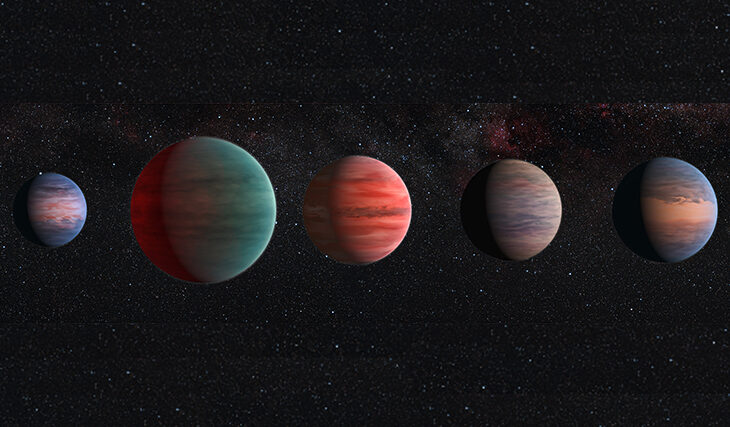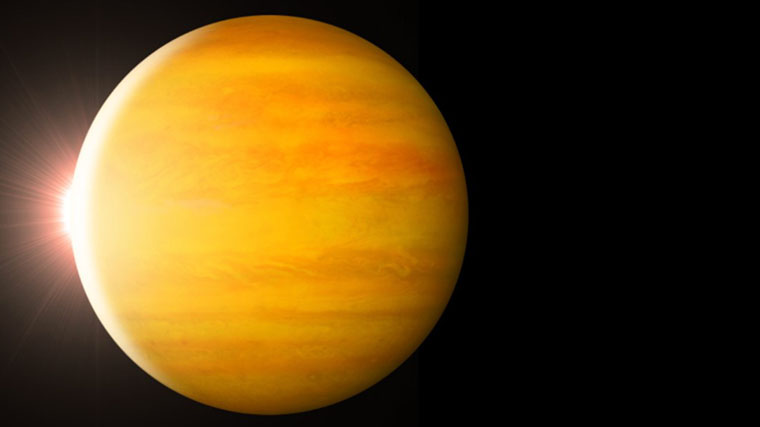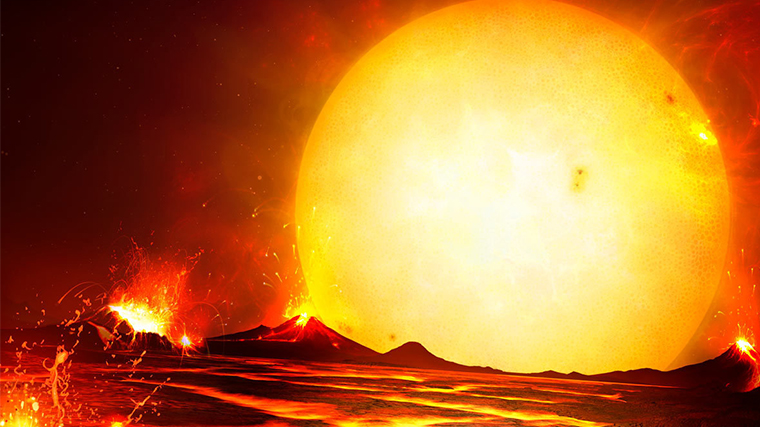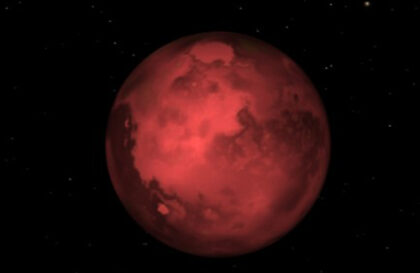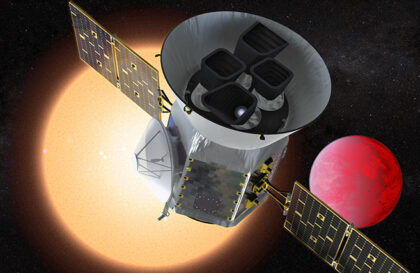The exoplanet HD 189733b occasionally has a pleasantly warm temperature of around 1,800 degrees Celsius (3,272 degrees Fahrenheit). For comparison, iron melts at a temperature of 1,535 degrees Celsius or 2,795 degrees Fahrenheit. Winds move at 5,400 miles per hour (or 8,690 km/h). This is the strongest wind recorded among all planets, approximately seven times faster than the speed of sound on Earth. Additionally, the winds carry silicate particles, and the planet occasionally experiences rains of molten glass. It is located 64.5 light-years from Earth and about 13% larger than Jupiter. It could contain a little over 1,400 Earths.
Image Credit: ESO/M. Kornmesser
The exoplanet PSR B1257 + 12 orbits a star in the constellation of Virgo. This tiny planet is one of the most inhospitable for life ever discovered. Instead of roasting you or tearing you apart with wind, this planet will fry you with radiation lasers. The star of this planet is a pulsar—a collapsed neutron star—that spins 161 times per second. Pulsars emit almost all their energy from their north and south poles, creating extremely concentrated “death rays” of radiation—jets. Essentially, their solar systems are drenched in immense radiation, enough to kill a human instantly.
An artist’s depiction of a pulsar, at right, and its exoplanet.
INSTITUTE OF ASTRONOMY, UNIVERSITY OF CAMBRIDGE
The exoplanet HAT-P-1b has a radius approximately 1.38 times larger than Jupiter’s, but its mass is only half that of Jupiter’s. This planet has about a quarter of the density of water. It’s lighter than a giant cork ball! Like Saturn, it would float in a bathtub if you could find one large enough to contain it, but it would float almost three times higher. No mathematical equations can describe the structure of this exoplanet. It orbits one member of a binary star system 450 light-years away from us in the constellation Lacerta. It orbits close to its parent star, completing a full revolution around it every 4.5 Earth days. The binary star system of which HAT-P-1b’s parent is a part is called ADS 16402 and is visible with binoculars.
Comparison of best-fit size of the exoplanet HAT-P-12 b with the Solar System planet Jupiter
The exoplanet 1SWASP J1407 b has a mass of 20 ± 6 MJ, suggesting that the object is most likely a brown dwarf. There is no consensus in the scientific community on how to classify this object in the system. The ring system of 1SWASP J1407 b is the first to be discovered outside of our Solar System and is the largest. The radius of a giant ring of 1SWASP J1407 b is estimated to be 0.6 AU, equivalent to about 56 million miles (90 million kilometers). For comparison, the radius of Saturn’s most giant ring is only about 300,000 miles (480,000 kilometers). The mass of 1SWASP J1407 b rings is approximately equal to 734×10^22 kg. The system consists of approximately 37 rings, each with a diameter of tens of millions of kilometers. It is located 434 light-years (about 133 parsecs) away from Earth in the direction of the constellation Centaurus.
Artist’s conception of the extrasolar ring system circling the young giant planet or brown dwarf J1407b. The rings are shown eclipsing the young sun-like star J1407, as they would have appeared in early 2007. Credit: Ron Miller
If Saturn had similar rings, we could see them from Earth at night with the naked eye—this phenomenon would be much brighter than a full moon. The rings block 95% of the light from a young Sun-like star for several days. This implies that these rings have a very high material density from which moons could form. This moon formation could explain the gap or space between the rings, clearly visible in the new model.
OGLE-TR-56b is a “hot Jupiter” class exoplanet orbiting the yellow dwarf star OGLE-TR-56. A year on this planet lasts only 29 hours. Its mass is 1.45 times that of Jupiter, its radius is 1.23 times Jupiter’s, and its density is approximately 1.0 g/cm³. The surface temperature is estimated to be around 1700°C. The planet theoretically could experience iron rain.
Image credit: Celestia
Kepler-70b is most likely a rocky exoplanet with a mass of 0.44 Earth masses and a radius of 0.76 Earth radii. The surface temperature exceeds 7,000 Kelvin, making it the hottest known surface temperature among all exoplanets. It is even hotter than the surface of the Sun. A year on this planet lasts only 5.76 hours (345 minutes).
GU Piscium b (GU Psc b) is either an exoplanet (gas giant) or a sub-brown dwarf in the system of the young variable star GU in the constellation Pisces, located 156 light-years away from Earth. The exoplanet’s mass is estimated to be 11 ± 2 Jupiter masses. GU Psc b has an orbital period of 163,000 years and is located at a distance of about 2000 AU (around 300 billion kilometers) from its star. Earth is 150 million kilometers from the Sun, and Pluto is between 4.4 to 7.4 billion kilometers away.
This is an artist’s impression of GU Psc b and GU Psc. Image credit: Lucas Granito.
PSR B1620-26 b (Methuselah) is an exoplanet in the binary system PSR B1620-26 in the constellation Scorpius. It is located at a distance of 12,400 light-years from the Sun. The planet is one of the oldest known exoplanets; according to some estimates, its age is around 12.7 billion years. It orbits a pulsar and a white dwarf. Pulsars are stars that have survived a supernova explosion, making it unlikely for any planet to survive such a cataclysm in the system. Astronomers hypothesize that the planet likely formed near a star that later turned into a white dwarf, and then this solar system was pulled into the gravitational field of the pulsar. Such mergers of systems are rare in the plane of our Galaxy but are common in globular clusters.
Künstlerische Darstellung von PSR J1623-2631b
Currently, the stars peacefully orbit each other, and this binary system with an exoplanet is slowly drifting toward the center of the M4 cluster, where the density of stars is very high. Therefore, there is a high probability that PSR B1620-26 will experience new cataclysms, and the fate of the planet PSR B1620-26 b remains unknown.
Image credit:
https://elt.eso.org
https://www.newsweek.com
https://www.nasa.gov
https://www.facebook.com
https://www.openexoplanetcatalogue.com
https://en.wikipedia.org
https://ru.wikipedia.org
https://www.sci.news/astronomy
https://de.wikipedia.org
